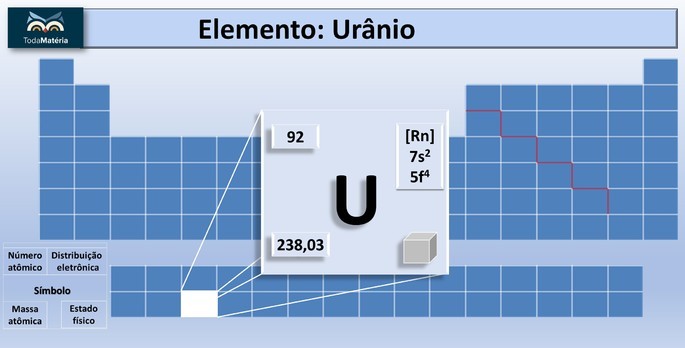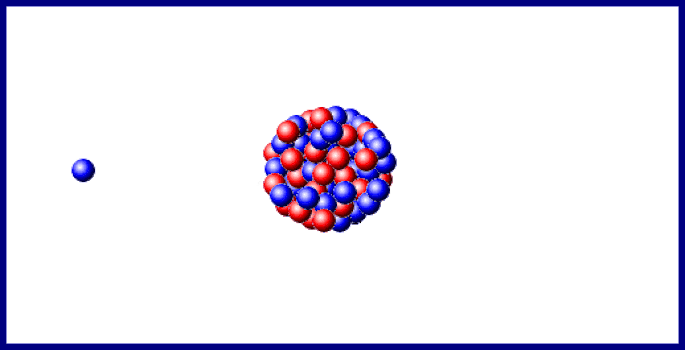Uranium is a chemical element in the Periodic Table represented by the symbol U, whose atomic number is 92 and belongs to the actinide family.
It is the element with the heaviest atomic nucleus in nature.
The most well-known isotopes of uranium are: 234 U, 235 U and 238 U.
Due to the radioactivity of this metal, its greatest application is in generating nuclear energy through the fission of its nucleus. In addition, uranium is used for dating rocks and nuclear weapons.

Characteristics of Uranium
- It is a radioactive element.
- High hardness dense metal.
- Ductile and malleable.
- Its color is silvery gray.
- It is found in abundance in the solid state.
- Its atom is highly unstable and the 92 protons in the nucleus can be disintegrated and form other chemical elements.
Uranium Properties
Physical properties
| Density | 18.95 g / cm 3 |
|---|---|
| Fusion point | 1135 ° C |
| Boiling point | 4131 ° C |
| Toughness | 6.0 (Mohs scale) |
Chemical properties
| Classification | Internal transition metal |
|---|---|
| Electronegativity | 1.7 |
| Ionization energy | 6.194 eV |
| Oxidation states | +3, +4, +5, + 6 |
Where is uranium found?
In nature, uranium is found mainly in the form of ores. To explore the reserves of this metal, the present content of the element and the availability of technology to perform the extraction and exploitation are studied.
Uranium ores
Because of the ease of reaction with oxygen in the air, uranium is normally found in the form of oxides.
| Ore | Composition |
|---|---|
| Pitchblende | U 3 O 8 |
| Uraninite | OU 2 |
Uranium in the world
Uranium can be found in different parts of the world, being characterized as a common ore because it is present in most rocks.
The largest uranium reserves are found in the following countries: Australia, Kazakhstan, Russia, South Africa, Canada, the United States and Brazil.
Uranium in Brazil
Although not all of the Brazilian territory has been prospected, Brazil occupies the seventh position in the world ranking of uranium reserves.
The two main reserves are Caetité (BA) and Santa Quitéria (CE).
Uranium Isotopes
| Isotope | Relative abundance | Half life time | Radioactive activity |
|---|---|---|---|
| Uranium-238 | 99.27% | 4,510,000,000 years | 12,455 Bq.g -1 |
| Uranium-235 | 0.72% | 713,000,000 years | 80.011 Bq.g -1 |
| Uranium-234 | 0.006% | 247,000 years | 231 x 10 6 Bq.g -1 |
Because it is the same chemical element, all isotopes have 92 protons in the nucleus and, consequently, the same chemical properties.
Although the three isotopes have radioactivity, the radioactive activity is different for each of them. Only uranium-235 is a fissionable material and, therefore, useful in the production of nuclear energy.
Radioactive Uranium Series
Uranium isotopes can undergo radioactive decay and generate other chemical elements. What happens is a chain reaction until a stable element is formed and the transformations cease.
In the following example, the radioactive decay of uranium-235 ends with lead-207 being the last element in the series.

This process is important for determining the age of the Earth by measuring the amount of lead, the last element in the radioactive series, in certain rocks that contain uranium.
History of Uranium
Its discovery occurred in the year 1789 by the German chemist Martin Klaproth, who gave it this name in honor of the planet Uranus, discovered also around this period.
In 1841, uranium was isolated for the first time by the French chemist Eugène-Melchior Péligot through a reduction reaction of uranium tetrachloride (UCl 4 ) using potassium.
Only in 1896, the French scientist Henri Becquerel discovered that this element had radioactivity when carrying out experiments with uranium salts.
Uranium applications
Nuclear energy

Uranium is an alternative source of energy for existing fuels.
The use of this element to diversify the energy matrix is due to the increase in the price of oil and gas, in addition to the environmental concern with the release of CO 2 into the atmosphere and the greenhouse effect.
Energy production occurs through the fission of the uranium-235 nucleus. A chain reaction is produced in a controlled manner and the countless transformations that the atom undergoes release energy that moves a steam generation system.
The water is transformed into steam when receiving energy in the form of heat and causes the turbines of the system to move and generate electricity.
Transformation of uranium into energy
The energy released by uranium comes from nuclear fission. When a larger nucleus breaks, a large amount of energy is released in the formation of smaller nuclei.
In this process, a chain reaction occurs that starts with a neutron reaching a large nucleus and breaking it down into two smaller nuclei. The neutrons released in this reaction will cause other nuclei to fission.

When hit by a neutron, uranium-235 divided into two smaller nuclei and released 3 neutrons.
The energy released in this reaction is 2.10 10 kJ / mol. In the combustion of ethanol, the energy released is 98 kJ / mol. Given this, we can see the magnitude of this process, whose energy produced is practically a trillion times greater than a combustion reaction.
Nuclear power in Brazil
Brazil has two nuclear plants that use enriched uranium. They are located in the municipality of Angra dos Reis (RJ).
According to Eletronuclear, a company that operates thermonuclear plants in Brazil, Angra 1 has the capacity to generate 657 electric megawatts, while Angra 2 can generate 1,350 electric megawatts.
Radiometric dating

In radiometric dating, radioactive emissions are measured according to the element generated in the radioactive decay.
Knowing the half-life of the isotope it is possible to determine the age of the material by calculating how much time has passed for formation of the product found.
The uranium-238 and uranium-235 isotopes are used to estimate the age of igneous rocks and other types of radiometric dating.
Atomic bomb

In the Second World War, the first atomic bomb was used, which contained the element uranium.
With the uranium-235 isotope, a chain reaction started from the fission of the nucleus, which in a fraction of a second, generated an explosion due to the extremely potent amount of energy released.
